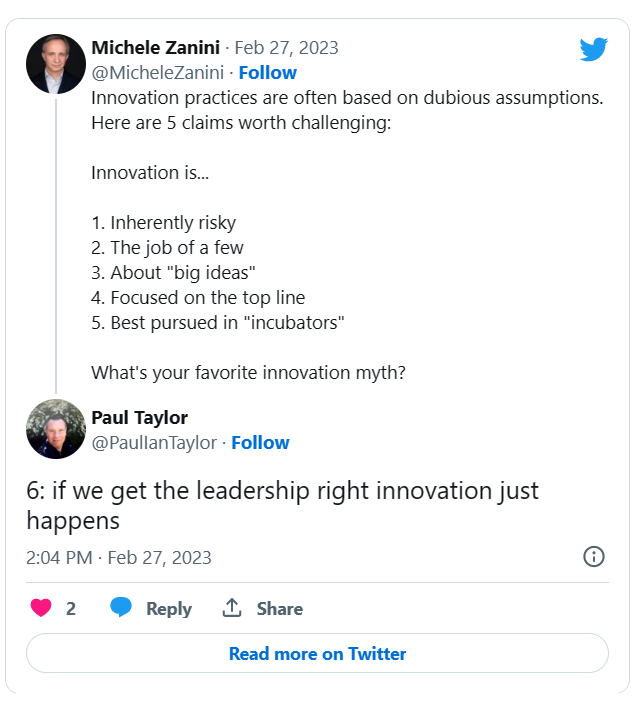What’s your favourite innovation myth? Michele Zanini started a good Twitter thread on this subject, to which I responded:

Trickle down innovation, just like trickle down economics, doesn’t trickle down very far.
When leaders are implored to innovate they often go for the easiest and most attractive option, innovation theatre:
- You bring someone in to give an “inspirational talk” on innovation
- You hold a one-day workshop to get your company to be more creative
- You can get a cool space with loads of beanbags and motivational posters
- You have a hackathon
Coined by Steve Blank the term innovation theatre is where ideas – arguably the easiest bit of the innovation process – are valued more than the discipline of turning those ideas into profitable business models or concepts. This requires a level of leadership commitment that is often harder to get.
A ideas focused culture is exacerbated by the following conditions:
- Leadership putting pressure on finding quick fixes and the realisation of short term goals — rather than exploring long term impact
- Discussing problems, or considering that organisation itself may be part of the problem, is seen as taboo or a sign of weakness, or even as a waste of time
- Management falling in love with a solution too easily even if it’s not solving the problem at hand
Innovation will mean different things to different people in your organisation – there is no one size fits all.
- The colleague on the frontline often just needs barriers to doing their job removing rather than moonshots. Removing that barrier is often all the ‘innovation’ they need.
- The CEO fears becoming irrelevant and losing market share. They are looking for big shifts.
- The People and HR functions want to foster an environment that promotes creativity, where people can generate new ideas that build a culture folks want to be part of.
- Customer services want innovation management that enables them to identify and address changing customer needs and create new value.
- Finance teams want to develop new revenue streams, or more often than not, just to cut costs.
In an innovation mature company all of these things can uncomfortably co-exist – but it cannot happen by magic. It needs curation and , yes, management. There are no shortcuts in building an innovative and productive culture and it requires operating on different levels and across multiple silos.
Because of these competing requirements and viewpoints any alien idea is usually rejected or resisted by the prevailing system. Therefore ideas that are new and that could complicate or even threaten the existing way of working means creating space where we can protect them.
It also needs protection from the organisational desire to complete things quickly. All the talk about agility is somewhat misplaced. If you work in innovation or design you’ll always see a time lag from inception to implementation. Even in the best organisations, it will take months, sometimes years, for new concepts to be assimilated into the everyday culture. Many (most) never make it.
That’s why there are always questions about how innovation or design teams spend their time and whether it’s worthwhile. When you’re working two years into the future it’s really hard to demonstrate outcomes that fit conventional performance frameworks.
There are some things you can do though:
- Have a consistent way to define and measure innovation, so that it’s unambiguous in your company
- Look for good problems rather than great ideas
- Periodically assess the areas of your business so that you know where each stands in terms of innovation capability and capacity
- Get senior leaders to identify and sponsor specific initiatives designed to address the key problems
- Assemble smalls teams to work on the challenges. Use disciplined protocols to help these teams succeed.
- Document, and track progress and share progress internally and externally.
- Create a pipeline of ideas that aligns with an innovation strategy or plan. Pipelines enable companies to drive innovation momentum, solve customer-centric problems and engage in a meaningful way.
To be an innovative organisation you need to be great at defining problems, at generating ideas, at selecting and executing them, and at getting them to spread.
Innovation doesn’t happen by accident – it happens by design.
Related: The Creativity Productivity Paradox

